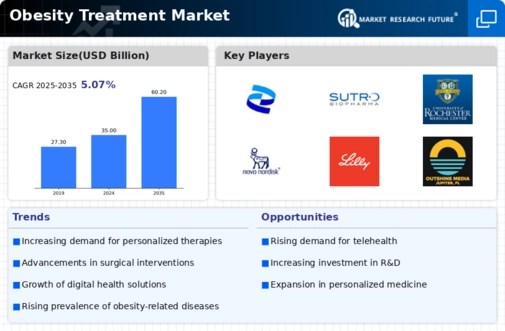Growing Prevalence of Obesity
The rising prevalence of obesity is a primary driver of the Obesity Treatment Market. According to recent data, approximately 42% of adults in the United States are classified as obese, a figure that has steadily increased over the past few decades. This alarming trend is mirrored in various regions, leading to heightened awareness and demand for effective treatment options. The increasing incidence of obesity-related comorbidities, such as diabetes and cardiovascular diseases, further propels the need for innovative solutions. As healthcare systems grapple with the economic burden of obesity, estimated to cost billions annually, the Obesity Treatment Market is likely to experience significant growth as stakeholders seek to address this pressing public health challenge.
Rising Awareness and Education
Increased awareness and education regarding obesity and its health implications are pivotal drivers of the Obesity Treatment Market. Public health campaigns and educational initiatives have successfully highlighted the risks associated with obesity, prompting individuals to seek treatment. This heightened awareness is reflected in the growing number of individuals actively pursuing weight management solutions, including medical treatments and lifestyle interventions. Additionally, healthcare professionals are increasingly trained to address obesity as a chronic disease, further promoting treatment options. As awareness continues to rise, the Obesity Treatment Market is likely to benefit from a more informed consumer base, leading to increased demand for diverse treatment modalities.
Advancements in Medical Technology
Technological advancements play a crucial role in shaping the Obesity Treatment Market. Innovations in medical devices, such as gastric balloons and implantable devices, have transformed treatment options, offering less invasive alternatives to traditional surgical procedures. Furthermore, the integration of telemedicine and mobile health applications facilitates remote monitoring and personalized care, enhancing patient engagement and adherence to treatment plans. The market for obesity-related medical devices is projected to expand, driven by these technological innovations. As healthcare providers increasingly adopt these advanced solutions, the Obesity Treatment Market is poised for substantial growth, catering to a more tech-savvy patient population seeking effective and convenient treatment options.
Government Initiatives and Policies
Government initiatives and policies aimed at combating obesity significantly influence the Obesity Treatment Market. Various countries have implemented strategies to promote healthier lifestyles, including subsidies for healthy foods and regulations on food marketing. These initiatives not only aim to reduce obesity rates but also encourage the development of treatment options. For instance, funding for obesity research and treatment programs has increased, fostering innovation within the industry. As governments recognize the economic and health burdens of obesity, the Obesity Treatment Market is expected to thrive, supported by favorable policies and funding aimed at improving public health outcomes.
Growing Demand for Weight Loss Solutions
The increasing demand for weight loss solutions is a driving force behind the Obesity Treatment Market. As societal norms shift towards valuing health and fitness, more individuals are seeking effective weight management options. This trend is evident in the rising sales of weight loss medications and dietary supplements, which have seen substantial growth in recent years. Additionally, the popularity of weight loss programs and clinics has surged, reflecting a broader cultural shift towards prioritizing health. The Obesity Treatment Market is likely to capitalize on this growing demand, as consumers actively pursue diverse and effective solutions to achieve their weight loss goals.

















Leave a Comment